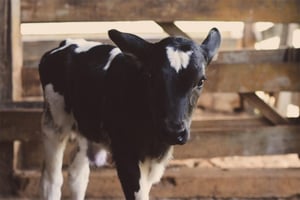
Calf pneumonia is a serious ailment with a heavy impact on production costs. This respiratory disease is a headache for cattle farmers all around the globe, particularly those working on slim margins. The virus has high morbidity and could result in significant, sometimes even fatal, lung damage. (1)
Even though it’s difficult to pinpoint the exact source of the viral infection, it’s critical to spot the signs of pneumonia and find ways to prevent it. This is a detailed guideline on how to deal with pneumonia in calves.
Discover professional insights on this topic from the eBook
What Is the Cause of Pneumonia in Calves?

Acquiring peace of mind for cattle farmers starts by figuring out the cause of the disease. Many factors can lead to pneumonia, for example, the animal could have viruses and bacteria present in its system. A major portion of calves gets their infection from their dams very early in life.
Some also obtain it from other domestic animals on the farm. Another cause of calf pneumonia is their immune system and environment. Inadequate nutrition can set the animal’s immunity in a downward spiral. With a poor immune system, the calf is susceptible to contracting this ailment.
Whereas cold temperatures, poor ventilation, increased humidity, and drought can make the animal more likely to get sick. The best way to find the cause is to get the herd tested. Cattle farmers get their herd tested when there is an outbreak. (2)
Pneumonia triggers lung inflammation. An infection in a pre-weaned calf can decrease milk production from 10% to 15% later in life. But, the impact of the ailment will vary based on its severity. However, if you catch the infection in the first 2 to 3 days, then the calf is more likely to completely recover. (3)
Signs of Pneumonia in Calves

Various types of pneumonia exist. Bacterial pneumonia typically appears in the first 6 to 10 days after the animal has been exposed to stress. Like shipping, for instance. Whereas interstitial pneumonia tends to emerge 70 or more days later. (4)
Chronic and acute pneumonia affects the animal differently. Acute pneumonia in calves symptoms include:
- Coughing
- Increased body temperature
- Discharge from the nose
- Irregular breathing
- Dropping of the head
- Feeling dull
- Lack of appetite
Chronic pneumonia appears more gradually. Even if the calf might continue to eat, it can still develop a nasal discharge, cough, or elevated respiratory rate. Any type of pneumonia can affect production costs and curb live weight gain. Sometimes, the animal can die because of it.
If your calf has an increased body temperature of over 39.5 °C (103 °F), it is critical to act fast. This could be an early sign of pneumonia. The sooner you start with the treatment, the better the odds of it being successful. (5)
How Do You Prevent Pneumonia in Calves?

Pneumonia prevention in calves starts with the animal’s immune system. Just like the human body, immunity in animals is a key factor in staying healthy. For better husbandry, curbing the exposure to some environmental factors and stress can also turn the tide.
Although you can’t completely eliminate the risk of this ailment, you can incorporate a couple of preventive measures that can set you on the right track. These measures include:
- Proper hygiene
- Adequate nutrition
- Keeping the animals at a comfortable temperature
- Proper ventilation
- Providing enough space in the enclosure
- Vaccination
- Separating the animals by age groups
- Decreasing stress during transport
To maximize the calf’s immunity, vaccination remains a top priority. A vaccine can help the animal’s body create antibodies, which can fight off the infection. So, when should a calf be vaccinated for pneumonia? Ideally, the vaccination program should start when the calf is 2 weeks old.
It would receive 2 shots, four weeks apart. If there is a risk of an outbreak, then a booster shot may be suggested. Talk to a vet to know which vaccine to go for and whether your animal is infected. Another practical prevention tactic is to have a thermometer in the shed. (6)
You can use it to check the temperature and ensure that the animal lives in comfortable conditions. If it is less than 10 °C (50 °F), and the calf is about 3 to 8 weeks old, then it’s good for the animal to wear a jacket. But, for calves 2 weeks or younger, staying in less than 15 °C (59 °F) can put them at risk of disease. To make sure the calf is not cold, use a jacket. (7)
Pneumonia prevention by improving the environment

Vaccination is still a top priority, but it is not effective against unvaccinated bacteria, and even if vaccinated, it may not be effective if the number of bacteria is too high.
That is why prevention by improving the environment is important, along with vaccination. Sterilize the space and reduce the bacteria itself.
Points to prevent pneumonia are:
- Vaccination to increase immunity.
- Spraying HOCl (hypochlorous acid water) to improve the feeding environment and reduce bacteria.
Reference: HOCL (HYPOCHLOROUS ACID WATER): ALL YOU NEED TO KNOW
Reference: 4 BENEFITS OF HOCL FOGGING (HYPOCHLOROUS ACID)
Changes in the number of airborne bacteria
In a preliminary test conducted by Kagoshima University at an animal facility on campus, the number of bacteria in the air was reduced to 1/10 in about 30 minutes after spraying with HOCl, and was further reduced to 1/100 in one hour, after which it was proven to be as close to zero as possible.

Interview survey on respiratory diseases
As a result of an interview survey conducted by Kagoshima University, it was confirmed that the incidence, duration of treatment, and recurrence rate of respiratory diseases such as pneumonia were improved before and after spraying HOCl. The results of this survey were based on a four-month period, but after that, the incidence of respiratory diseases was reduced to almost zero by continuous spraying of HOCl.

Is Pneumonia in Calves Contagious?

Yes. Contagious bovine pleuropneumonia (CBPP) can easily spread in cattle. But, it takes time for it to develop. The calf can get exposed to other infected cattle, especially if the animal coughs nearby. Another way the ailment spreads is through fluids, reproductive tissue, saliva, and urine.
That’s why many experts recommend cattle farmers give their animals enough space to thrive and not overstock their enclosures. It’s important for the animal to have the freedom to move around and feel comfortable in the enclosure.
What Is the Best Medicine for Pneumonia in Calves?

The infected lungs will need 10 to 14 days to heal. So, pneumonia treatment will last as long as the lungs take to recover, even if the calf seems to be doing better in just a couple of days. The treatment, however, will vary based on the severity of the infection.
Some of the best medicines for the respiratory disease include Engemycin LA, Nuflor/Resflor, or Hexasol. Antibiotics are administered when they are critical to the calf’s survival. Only a vet can suggest the best form of treatment. (8)
Final Thoughts
Pneumonia in calves can be a real problem. Unless you have a couple of preventive tactics at hand, it can be difficult to mitigate the ailment. Once an animal gets infected, react quickly. Contact a vet and start with adequate treatment. The sooner you focus on treating the issue, the better the odds of the animal making a full recovery. Now that you know the ins and outs of this ailment, you can provide the animals with the care and protection they need.
Discover professional insights on this topic from the eBook below. Store the data and make it yours.

Reference
1. https://www.ncbi.nlm.nih.gov/pmc/articles/PMC7135460/
2. https://ahdb.org.uk/knowledge-library/pneumonia-in-calves
3. https://www.fwi.co.uk/livestock/health-welfare/livestock-diseases/6-signs-of-pneumonia-in-calves-to-look-out-for
4. https://www.ncbi.nlm.nih.gov/pmc/articles/PMC7185769/
5. https://www.farmantibiotics.org/wp-content/uploads/2018/08/XLVets-Farming_Fact_Sheet_-_Calf_Pneumonia_0.pdf
6. https://www.bovilis.ie/pneumonia/
7. https://www.fwi.co.uk/livestock/health-welfare/qa-pneumonia-in-calves-and-how-to-combat-it
8. https://stbonifacevets.co.uk/news/appropriate-use-antibiotics-calf-pneumonia


